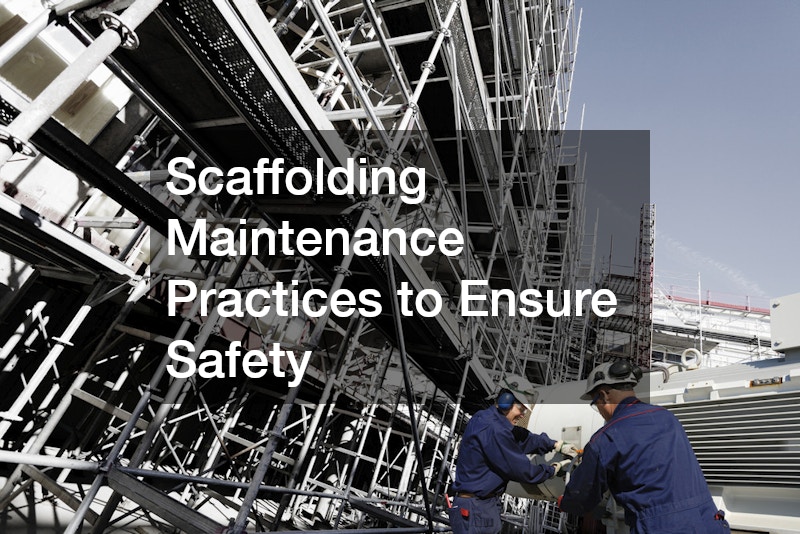Scaffolding plays a vital role in construction projects across Australia, providing workers with the stability and access they need to complete jobs at height. Proper maintenance is essential to ensure it remains safe and functional throughout a project’s duration. Neglecting upkeep can lead to accidents, costly delays and legal issues, making regular checks and repairs a priority for every construction site.
Conducting regular inspections
The first step in scaffolding maintenance is regular inspections. These should be carried out by a qualified person before the structure is first used, at least every 30 days, and after any incident that could affect its stability. Inspections involve checking for loose connections, damaged components and signs of corrosion or wear. Early detection of faults means they can be addressed before they create safety hazards.
A clear inspection log should be maintained, recording the date, findings and any corrective action taken. This documentation can be critical in demonstrating compliance with Work Health and Safety (WHS) regulations if an incident occurs.
Cleaning to prevent deterioration
Dust, dirt and construction debris can accumulate on scaffolding, leading to issues like rust and weakened joints over time. Regular cleaning with appropriate equipment helps to remove these contaminants. For steel components, it is important to ensure they are dry after cleaning to prevent moisture damage. For timber platforms, removing mud and water can reduce the risk of rot and prolong their lifespan.
Sites located near the coast should take extra care as salt in the air can accelerate corrosion. Washing the structure with fresh water more frequently in these environments helps protect its integrity.
Repairing damaged components promptly
Damaged parts should never be ignored or left in service. Any bent frames, cracked boards or worn couplers must be repaired or replaced immediately. Continuing to use faulty components can compromise the entire structure’s stability, putting workers at risk. It is best practice to have spare parts readily available on site so repairs can be made without delays.
Repairs should always be carried out by a competent person following the manufacturer’s specifications. Improvised fixes or unapproved components can create hidden dangers.
Storing equipment correctly
Proper storage extends the service life of scaffolding when it is not in use. Components should be stacked neatly on level ground, away from heavy-traffic areas where they could be damaged. Steel parts should be kept under cover when possible to shield them from rain and sun exposure, while timber platforms should be stored in a dry area with good ventilation.
Incorrect storage can cause warping, corrosion or accidental damage, making the equipment unsafe for future use.
Training workers in safe use
Even the best-maintained scaffolding can be dangerous if workers are not trained in safe use. All team members should receive instruction on proper assembly, access methods and load limits. They should also be encouraged to report any defects they notice during daily use.
Supervisors play a key role in ensuring safety practices are followed. This includes enforcing weight restrictions, preventing unauthorised modifications and ensuring that personal protective equipment is used correctly.
Complying with Australian safety standards
In Australia, scaffolding safety is governed by WHS regulations and Australian Standards such as AS/NZS 1576. These set out requirements for design, construction, inspection and maintenance. Compliance is not only a legal obligation but also a vital step in protecting workers from harm.
Failing to meet these standards can lead to significant penalties and reputational damage for construction companies. Staying informed about regulatory updates ensures ongoing compliance.
Using protective coatings
Applying protective coatings to steel components can help prevent corrosion and extend the life of the equipment. Galvanising, painting or powder-coating creates a barrier between the metal and environmental elements. Re-coating may be necessary over time, especially in harsh conditions.
Timber platforms can be treated with sealants to protect against moisture and UV damage. These treatments should be reapplied as needed to maintain their effectiveness.
Managing loads effectively
Overloading scaffolding is one of the most common causes of accidents. Workers should be aware of the maximum load capacity and ensure materials are evenly distributed across platforms. Heavy loads should be moved using mechanical lifting equipment rather than manual carrying, which can strain the structure.
Load management also includes avoiding the accumulation of waste materials on the platforms, which can add unnecessary weight and create trip hazards.
Planning for adverse weather
Strong winds, heavy rain and extreme heat can all impact the safety of scaffolding. Weather conditions should be monitored closely, and work at height suspended when conditions become unsafe. Temporary measures such as securing loose materials and adding wind braces can help stabilise the structure during storms.
After severe weather, a thorough inspection should be conducted before resuming work to ensure the scaffolding remains secure.
Documenting maintenance efforts
Keeping detailed records of all maintenance activities is an important part of site safety. These records should include inspection dates, identified issues, repairs carried out and the names of those involved. Having this information on hand demonstrates a commitment to safety and can be crucial in the event of an audit or investigation.
Prioritising safety to protect lives
Scaffolding maintenance is not just about meeting legal requirements – it is about ensuring every worker returns home safely at the end of the day. By implementing regular inspections, prompt repairs, proper storage and thorough training, construction teams can significantly reduce the risk of accidents.
When safety is prioritised from the start, projects run more smoothly, equipment lasts longer and teams can work with confidence. Ongoing maintenance is a small investment compared to the cost of an accident, both financially and personally.

